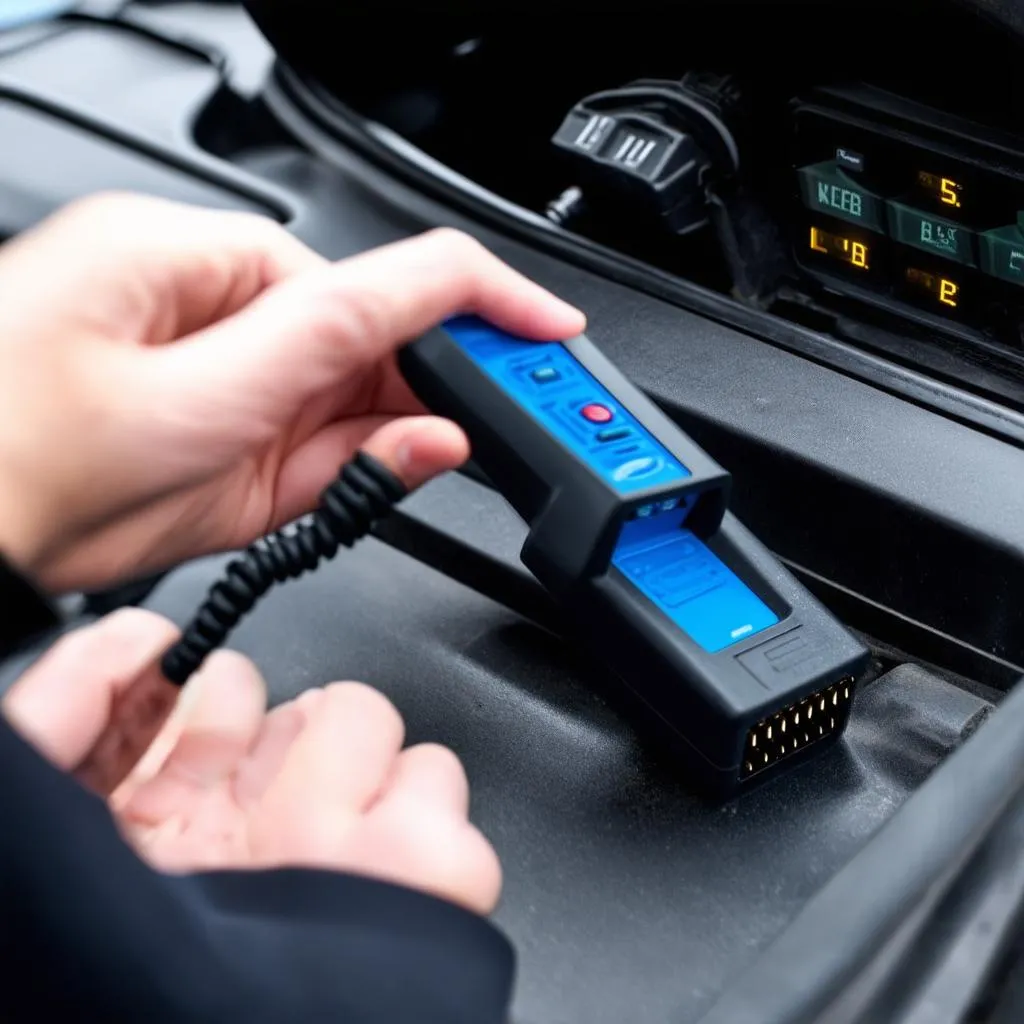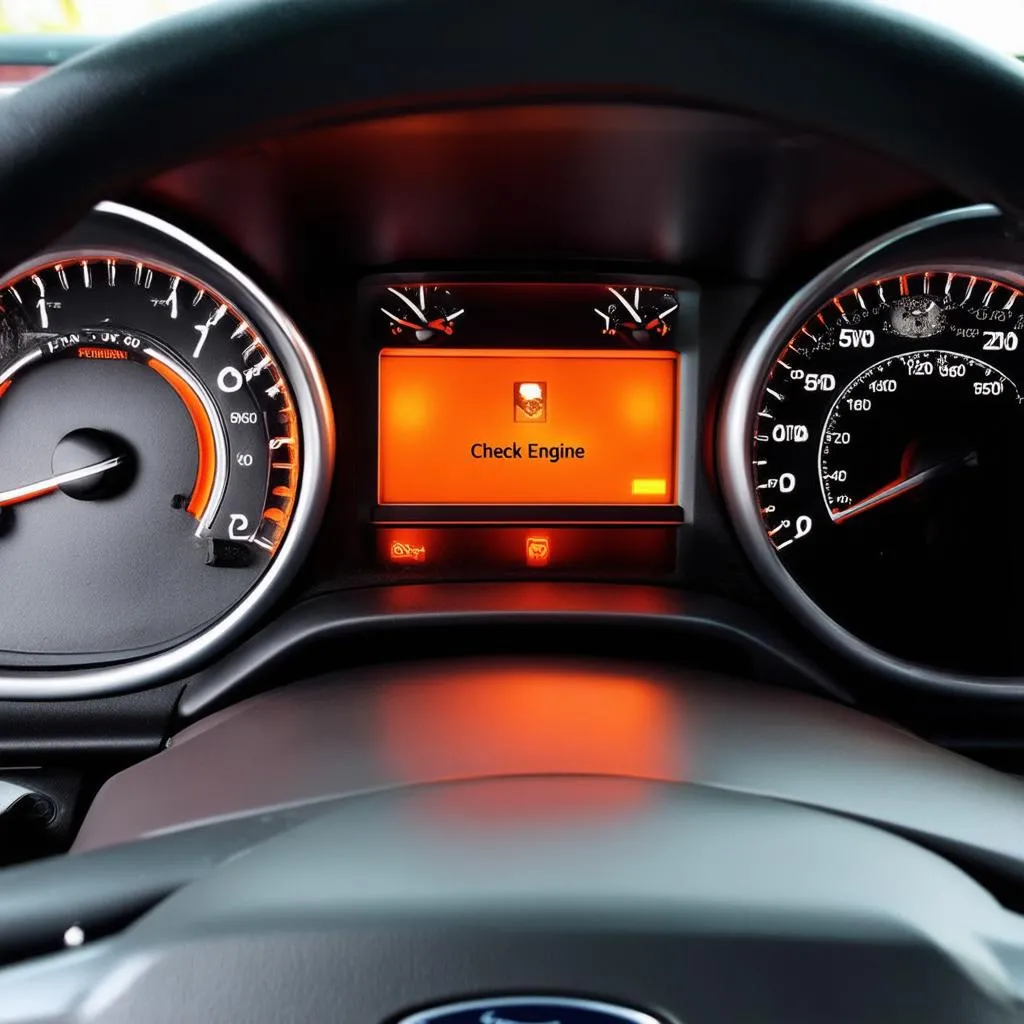Have you ever encountered a blinking check engine light in your Ford and wondered what it meant? You’re not alone! Many Ford owners find themselves scratching their heads when faced with this cryptic warning. But fear not, dear reader! This comprehensive guide will unravel the mysteries of Ford OBD II codes and equip you with the knowledge to diagnose and address any issues that may arise.
Understanding Ford OBD II Codes: What Are They and Why Do They Matter?
Imagine this: You’re cruising down the highway, enjoying a scenic drive, when suddenly, a little orange light illuminates your dashboard. You pull over, heart pounding, wondering if your car is about to explode. This, my friend, is the dreaded check engine light, and while it may seem like a harbinger of doom, it’s actually a helpful signal designed to keep your Ford running smoothly.
The OBD II system (On-Board Diagnostics II) is like a silent guardian, constantly monitoring your Ford’s engine and emissions systems. When it detects a problem, it sets a diagnostic trouble code (DTC), which is essentially a message explaining the issue. These codes are a crucial tool for both you and your mechanic.
Deciphering the Code: What Do Ford OBD II Codes Mean?
Ford OBD II codes are typically a combination of letters and numbers, such as P0300, which signifies a problem with a misfire. The first letter (P, B, C, or U) tells you where the problem lies:
- P: Powertrain
- B: Body
- C: Chassis
- U: Network/communication
The next two digits (03) indicate the category of the problem, and the last two digits (00) represent the specific code.
Why You Should Know Your Ford OBD II Codes
Understanding Ford OBD II codes can be a lifesaver for several reasons:
- Early Warning System: They give you advance notice of potential issues before they escalate into major problems.
- DIY Repairs: For simple issues, you might be able to fix the problem yourself, saving you time and money.
- Better Communication with Mechanics: Knowing the codes allows you to communicate effectively with your mechanic and understand their diagnoses and repair recommendations.
Where to Find Your Ford OBD II Codes
You can retrieve your Ford OBD II codes using several methods:
- OBD II Scanner: These handy tools are available online or at auto parts stores. Simply plug the scanner into your car’s OBD II port (usually located under the dashboard) and follow the instructions to retrieve the codes.
- Smartphone App: Many free or paid apps allow you to connect your smartphone to your car’s OBD II port and read the codes.
- Mechanic: Your trusted mechanic can easily diagnose your Ford and provide you with the codes.
Common Ford OBD II Codes and Their Meanings
Here are some of the most common Ford OBD II codes and their potential causes:
P0300: Random/Multiple Cylinder Misfire
Description: This code indicates that your engine is experiencing misfires in one or more cylinders.
Potential Causes:
- Spark plugs or wires: Worn out, damaged, or loose spark plugs or wires can prevent the spark from reaching the cylinder.
- Fuel injectors: Clogged or faulty fuel injectors can prevent the proper amount of fuel from reaching the cylinder.
- Ignition coil: A failed ignition coil can prevent the spark from reaching the cylinder.
- Engine vacuum leaks: Leaks in the engine’s vacuum system can disrupt the air-fuel mixture.
- MAF sensor: A faulty mass airflow sensor can cause the engine to receive incorrect air readings.
P0171: System Too Lean (Bank 1)
Description: This code indicates that the air-fuel mixture in one of the engine banks is too lean, meaning there’s too much air and not enough fuel.
Potential Causes:
- Faulty oxygen sensor: A malfunctioning oxygen sensor can send incorrect readings to the engine control unit (ECU), causing it to adjust the fuel mixture incorrectly.
- Fuel injector leak: A leaking fuel injector can reduce the amount of fuel reaching the cylinder.
- Vacuum leak: Leaks in the engine’s vacuum system can cause the engine to draw in more air than it should.
- Clogged air filter: A dirty air filter can restrict airflow, leading to a lean mixture.
P0420: Catalyst System Efficiency Below Threshold (Bank 1)
Description: This code indicates that the catalytic converter on one of the engine banks is not functioning properly.
Potential Causes:
- Damaged catalytic converter: The catalytic converter itself may be damaged or clogged.
- Oxygen sensor problem: Faulty oxygen sensors can prevent the ECU from accurately monitoring the catalyst’s performance.
- Exhaust leak: Leaks in the exhaust system can bypass the catalytic converter, reducing its effectiveness.
Tips for Resolving Ford OBD II Codes
- Check the Code: First, use a scanner to retrieve the code and consult a repair manual or online resources to understand its meaning and potential causes.
- Inspect the System: Visually inspect the related components, such as spark plugs, wires, fuel injectors, air filter, and oxygen sensors.
- Clear the Code: After addressing the suspected issue, clear the code and test drive your Ford. If the code returns, you’ll need to investigate further.
- Consult a Mechanic: If you’re unable to diagnose the problem, consult a trusted mechanic.
Frequently Asked Questions (FAQs)
Can I Clear My Ford OBD II Codes Myself?
Yes, you can clear your Ford OBD II codes yourself using a scanner. However, simply clearing the code won’t fix the underlying problem. The code will likely reappear if the issue hasn’t been addressed.
What Does “Pending Code” Mean?
A pending code means that the OBD II system has detected a potential problem, but it hasn’t occurred frequently enough to trigger the check engine light. You may want to monitor the situation and consider addressing the issue before it becomes more serious.
How Often Should I Check My Ford OBD II Codes?
It’s a good idea to check your Ford OBD II codes regularly, at least once a year or whenever you notice a problem. This can help you catch issues early and prevent them from escalating.
Can I Drive My Ford with a Check Engine Light On?
It’s generally not recommended to drive your Ford with a check engine light on. The light indicates a potential problem that could affect your engine’s performance, fuel economy, or emissions. If the issue is ignored, it could lead to further damage.
Are Ford OBD II Codes Specific to My Model?
Some Ford OBD II codes may be more common in certain models. You can consult your owner’s manual or online resources for specific information about your Ford.
Ford OBD II Codes: A Window into Your Car’s Health
Ford OBD II codes are your car’s way of communicating with you. By understanding these codes, you can be proactive about maintaining your Ford’s health, ensuring it runs smoothly for years to come.
 Ford OBD Scanner
Ford OBD Scanner
 Ford Check Engine Light
Ford Check Engine Light
Want to Learn More?
For a deeper dive into specific Ford OBD II codes, check out these resources:
- Ford Owner’s Manual: This valuable guide contains detailed information about your Ford model, including its OBD II system and code definitions.
- Online Forums: There are many online forums dedicated to Ford vehicles, where you can connect with fellow owners and get expert advice.
- Technical Manuals: If you’re a DIY enthusiast, you can find comprehensive repair manuals for your Ford, which include detailed information on OBD II codes and their associated repairs.
Need Expert Help?
If you’re still unsure about your Ford OBD II codes, don’t hesitate to contact us at TechCarUSA. Our team of experienced mechanics and diagnostics experts can help you identify and address any issues. Just contact us via Whatsapp: +84767531508.
Stay Connected!
Do you have any questions or insights about Ford OBD II codes? Share your thoughts in the comments section below. We also invite you to explore other informative articles on TechCarUSA about Ford diagnostics, repair, and maintenance.